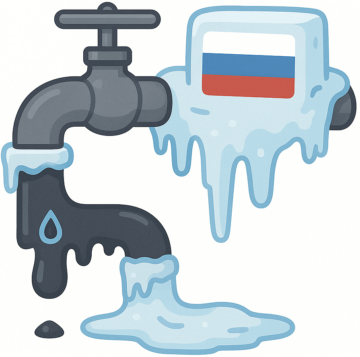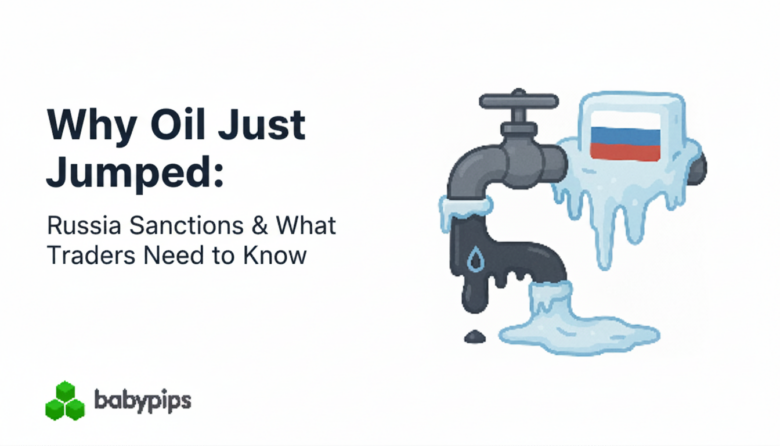Oil had a monster day on Thursday, clocking its biggest one-day jump in more than four months. WTI crude popped 5.6% to hit $62 a barrel, while Brent climbed all the way to $66.
And no, it’s not because Nobody Wants This Season 2 just dropped and everybody decided to Netflix and chill instead of driving around.
This week, traders were blindsided after U.S. President Trump slapped sanctions on Russia’s two BIGGEST oil companies.
Wait, What?
 On October 22, 2025, the Trump administration sanctioned Rosneft and Lukoil, which together produce about 3.1 million barrels per day.
On October 22, 2025, the Trump administration sanctioned Rosneft and Lukoil, which together produce about 3.1 million barrels per day.
That’s nearly 50% of Russia’s crude oil exports and about 5% of global oil output!
Treasury Secretary Scott Bessent announced:
“Given President Putin’s refusal to end this senseless war, Treasury is sanctioning Russia’s two largest oil companies that fund the Kremlin’s war machine.”
The move came just one day after Trump canceled a planned summit with Putin in Budapest, saying, “Every time I speak with Vladimir, I have good conversations and then they don’t go anywhere.”
“Sanctioning” the two companies means:
- The U.S. will freeze all U.S.-based assets of Rosneft and Lukoil
- The U.S. will bar American companies from doing business with them
- The U.S. is threatening “secondary sanctions” on foreign banks dealing with these firms
- The U.S. added 30+ subsidiaries (smaller companies owned or controlled by Rosneft and Lukoil) to the sanctions list.
And if that’s not enough, the EU announced its 19th sanctions package the same day, including a ban on Russian LNG imports starting 2027.
What makes the decision more shocking is that, with WTI hitting multi-year lows at $57 last week, traders assumed Trump would avoid energy sanctions before the 2026 midterms.
They were wrong.
Why It Matters: The Supply Shock Nobody Priced In
These sanctions directly threaten a massive chunk of global oil supply. India imported about 1.6 million barrels per day from Russia in 2025, while China took roughly 2 million barrels per day.
Here’s the difference: Previous sanctions included a $60-per-barrel price cap designed to limit Russian revenue without disrupting supply. Russia could still sell; it just accepted lower prices.
These new sanctions are far more aggressive. They effectively tell refiners in India and China: “Keep buying from Rosneft and Lukoil, and you risk getting cut off from the Western financial system.”
For most companies, that’s a deal-breaker.
Market reactions:
Heating oil led the charge with a 6.8% jump, while U.S. oil majors like ExxonMobil, ConocoPhillips, and Diamondback also rallied.
Diesel and gasoline futures climbed as traders priced in tighter global supply.
If India and China curb Russian imports, it could shrink available barrels or push them through riskier routes, boosting demand for oil from other regions.
What Happens Next?
The sanctions don’t take full effect until November 21, but the market impact is happening now.
Gas Prices Rising
Motorists will likely see pump price increases within days. The U.S. average just dipped below $3 per gallon, but may change fast and influence consumer behavior negatively.
Buyers Already Reacting
Chinese state oil companies (PetroChina, Sinopec, CNOOC) have already suspended short-term purchases from Rosneft and Lukoil. Indian refiners are scrambling for alternatives.
OPEC+ Next Move
OPEC+ meets November 2. They’ve been adding 137,000 barrels per day monthly and have spare capacity.
Will Saudi Arabia step in to offset Russian disruptions? How about OPEC+?
Russia’s Workarounds
Putin himself downplayed the sanctions, calling them an “unfriendly act” but claiming Russia has “developed a strong immunity to Western restrictions.”
Russia has a “shadow fleet” of aging tankers for sanctions evasion. Analysts estimate at least 1 million barrels per day might keep flowing through offshore entities and willing buyers who’ll take the compliance risk.
Key Short-term Takeaways for Traders
1. Geopolitical Risk Premiums Appear Instantly
One day oil traded near $57 with traders pricing in a glut. The next day it jumped 6%.
When trading energy, size positions knowing policy announcements can create gaps that stop-losses won’t protect against.
2. The First Move Isn’t the Whole Story
Today’s 6% jump is just the opening act. With sanctions kicking in on November 21 and an OPEC+ meeting on November 2, volatility is about to crank up.
As India and China hunt for alternatives, traders should brace for more headlines and more potential intraday and swing trade setups in oil.
3. Supply Disruptions Have Knock-On Effects
Heating oil jumped even more than crude. Oil stocks rallied. When major disruptions hit, trace through which assets benefit and which get hurt. The direct play isn’t always the best play.
4. Enforcement Is Everything
Sanctions work only if enforced. Russia has evaded them before using shell companies and sketchy tankers. The market will watch whether India and China actually stop buying or find workarounds. That’s the difference between a sustained rally and a quick fade.
Next Dates That Could Move Oil Prices
The next few weeks will reveal whether this is just a short-term jolt or the start of a lasting disruption.
- November 2: OPEC+ meeting
- November 21: Sanctions fully take effect
- U.S. pump prices: If gas climbs toward $3.50 or higher, political pressure will intensify
- Import data: Key question is whether China and India are actually cutting Russian purchases
Thursday’s rally was mostly driven by uncertainty. Traders are pricing in the risk that 3.1 million barrels a day could become harder to buy, even if the real supply hit takes weeks to show.
But Russia will likely try to dodge sanctions, China and India will look for workarounds, and OPEC+ could step in to steady the market.
If prices climb too high before the election, Trump might also ease sanctions to cool things off.
Volatility brings both opportunity and danger. If you’re trading energy, make sure your positions can handle markets that move 5% on a single headline.
Disclaimer: This article is for educational purposes only and does not constitute financial advice. Trading and investing involve risk, including the potential loss of principal. Always conduct your own research and consider consulting with a qualified financial advisor before making investment decisions. Past performance is not indicative of future results.



